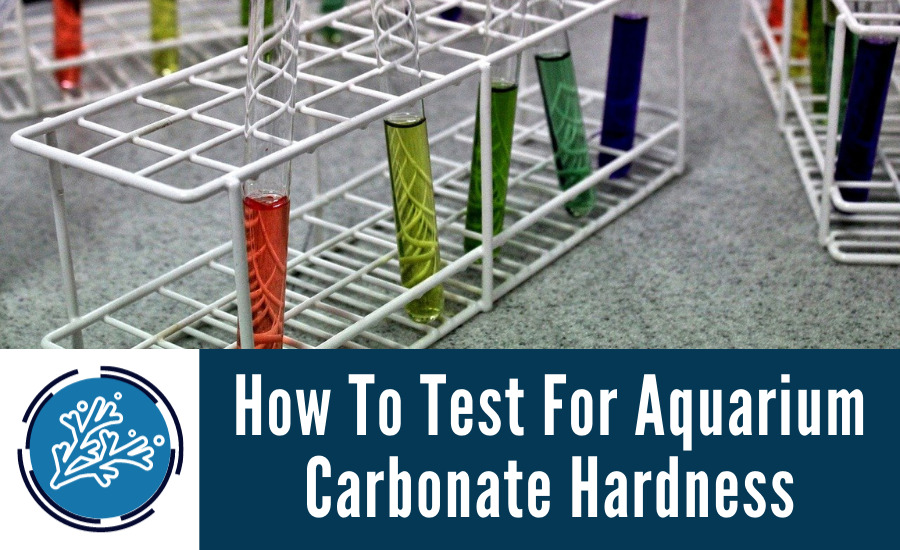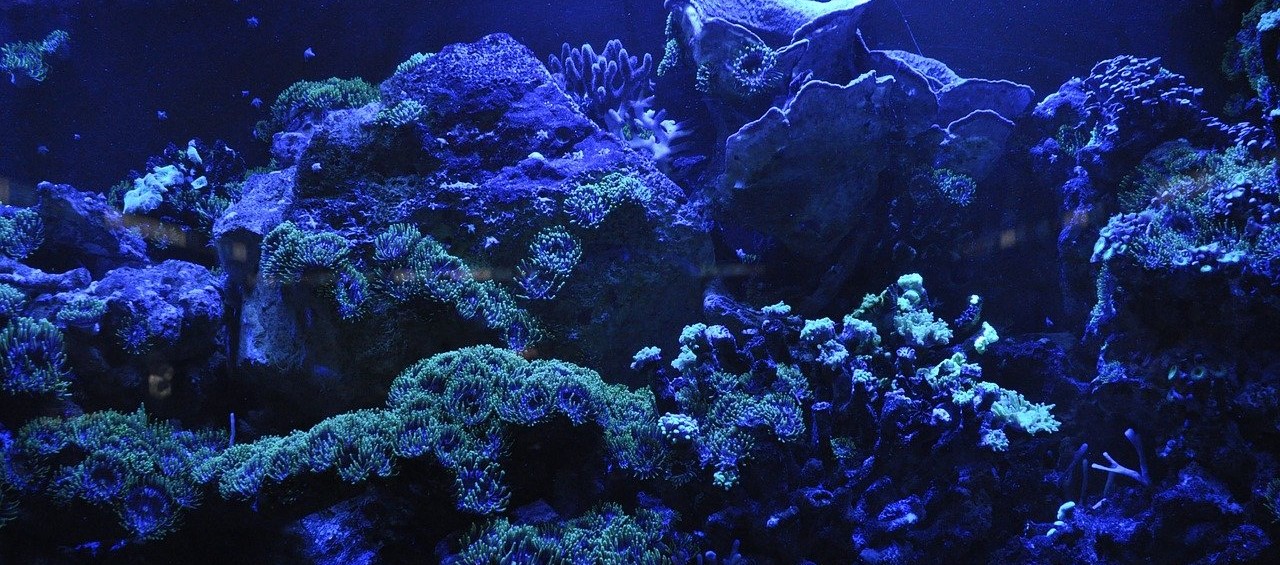Last Updated on February 10, 2023 by Matt
Carbonate hardness is an important part of aquarium water chemistry. So knowing exactly what it is and what affects it is very important in being able to keep your fish tank as healthy as it can be.
Carbonate hardness is also known as the aquarium KH, or just KH, and is measured in degrees of carbonate hardness, or dKH.
In this article we will explain what aquarium KH is, why it is important, what can affect it and how to replenish it.
IN THIS ARTICLE
What Is Aquarium Carbonate Hardness

Aquarium carbonate hardness is the measure of carbonate (CO32-) and bicarbonate (HCO3–) ion concentration in your aquarium. It is measured in degrees of carbonate hardness (°KH), written mainly just as dKH.
While you might not think it, these ions are essential in both freshwater and saltwater tanks, especially reef tanks.
Carbonate hardness is also referred to as the alkalinity, total alkalinity, buffering capacity, and acid neutralizing capacity. It is referred to in these terms as it serves an important role in regulating the pH of the water column. KH can also be known as temporary hardness.
Why is Aquarium KH Important?
Aquarium carbonate hardness is incredibly important in a number of ways.
First of all, coral exoskeletons, and mollusk shells, are made of calcium carbonate. They will actively draw calcium and carbonate and bicarbonate ions from the water to make their skeletons.
Secondly, aquarium KH works to resist changes in pH. The diagram below shows the delicate equilibriums that exist in your tank between carbon dioxide (CO2), carbonic acid (H2CO3), bicarbonate (HCO3–), and carbonate (CO32-). Carbonic acid is basically dissolved carbon dioxide.
<———————Decreasing pH———————
CO2 + H2O ⇌ H2CO3 ⇌ HCO3– + H+ ⇌ CO32- + 2H+
———————–Increasing pH———————>
If the pH of the water is acidic, or below 7, then the primary equilibrium that exists is between bicarbonate and carbonic acid. As the pH falls more bicarbonate is converted to carbonic acid.
As the pH of the water becomes more alkaline, the equilibrium changes. If the pH is above 8.3, the primary equilibrium in the water will be that between the bicarbonate and carbonate ions.
So you can say that in alkaline water, the dKH will be higher than that in acidic water, as the equilibrium is between bicarbonate and carbonate, the ions that make up KH.
But while KH is linked to pH, increasing or decreasing pH will increase or decrease bicarbonate and carbonate ion concentration respectively, pH is also linked to KH. If you increase the dKH of the aquarium water, you will increase the pH as well. The higher dKH of the water, the greater buffering capacity of your tank, as it takes more acid to convert the carbonate and bicarbonate ions and swing the equilibrium.
We have explained all of this because swings and spikes in pH are very damaging to fish, plants, and invertebrates, including coral. If you have a good stable carbonate hardness in your aquarium then the pH will also be stable.
If you remember from our article on old tank syndrome, mature tanks tend to get more acidic over time. This is due to the fact that the build up of nitrate through the aquarium nitrogen cycle will lower pH. As fish expel carbon dioxide the pH will also be reduced.
Corals and other invertebrates like mollusks and echinoderms use carbonate predominantly in their calcium carbonate exoskeletons. They can also use bicarbonate but need to process it to convert it to carbonate before they can use it. As corals grow and use carbonate and bicarbonate, they shift the equilibrium, therefore lowering KH and also pH.
What Is The Difference Between Aquarium KH and GH?
Aquarium carbonate hardness details the carbonate and bicarbonate ion concentration in the tank. Aquarium general hardness is a similar, but fundamentally different measurement. It denotes the calcium and magnesium ion concentration in the water column.
KH has an effect on the pH of water, as it acts as a buffer to acids. Water with some degree of carbonate hardness will prevent water becoming acidic.
Sometimes general hardness and carbonate hardness can go hand in hand; for instance common compounds found in tap water or in some aquarium substrates are calcium carbonate and magnesium carbonate. Adding these compounds to your tank will increase both the GH and KH.
However you can also find that GH can be raised by having compounds such as calcium and magnesium phosphate in the tap water. This will raise GH without KH.
In nature a high GH usually comes with a high KH as well. This is also true of tap water sources. When people refer to “hard” or “soft” water they are talking about water with a high or low GH respectively.
What Is the Ideal Aquarium Carbonate Hardness?
The ideal aquarium carbonate hardness depends on the unique tank setup.
It will differ between freshwater and saltwater tanks, and is also dependent on what fish and invertebrate species you have in the tank.
What is certain is that no matter what kind of tank setup you have, you need some degree of carbonate hardness to your water. If you have little or no carbonate or bicarbonate ion concentration, then the aquarium is at risk of pH spikes, and the inhabitants will also be unhealthy.
The following table will give you a brief overview of what KH you should be aiming for in different aquarium setups.
| Community | 4-8 dKH |
| African Cichlids | 10-25 dKH |
| Plants & Soft Water Fish | 1-4 dKH |
| Discus | 1-4 dKH |
| Brackish | 8-18 dKH |
| Saltwater | 8-12 dKH |
| Reef | 8-12 dKH |
As you can see freshwater tanks in general need lower carbonate hardness than saltwater tanks. Planted tanks normally require a relatively low KH, but community tanks need a moderate KH. African cichlids require very hard water, and need a very high KH, as well as high GH. Saltwater tanks need a high KH to maintain a slightly alkaline pH, and reef tanks absolutely need this KH value to give corals the carbonate ions they need to produce their exoskeletons.
How To Test For Aquarium Carbonate Hardness

Testing for aquarium carbonate hardness is very simple. There are many brands of aquarium test strips which can be used to accurately test the water KH.
API is a very well known brand which produces a wide range of test kits for water chemistry. Their aquarium KH test kit works in both freshwater and saltwater tanks and gives an accurate reading, using drops and a color change to show the dKH.
The Salifert Carbonate Harness Alkalinity test is a very accurate test kit which gives a very precise and accurate reading of KH in both freshwater and saltwater tanks.
The Hanna Marine Alkalinity dKH Checker is different from the other two test kits here. It is very accurate and precise, but as marine is in the name, has use only in saltwater tanks. But when you need accuracy, this test may be the one for you. And it shows the dKH value in numbers, you don’t need to check color changes.
You need to check the aquarium carbonate hardness regularly. In saltwater and reef tanks you should be checking the KH every week. Corals require a good level of carbonate hardness, so it should be a priority. They are also highly sensitive to changes in pH, and some reef tank owners use KH testing as a measure of pH as well, as they go hand in hand, and only test pH every month or so.
For freshwater tanks it depends on what KH levels your setup requires. If you need a low KH, then once every couple of weeks or month is fine. However for community tanks and tanks which require hard water you should be testing every week.
How To Increase Aquarium KH
If you have discovered by testing the water chemistry that the carbonate hardness has got too low, there are a number of things you can do to raise the KH.
Alkalinity Buffer
Alkalinity buffers work to increase the level of carbonate and bicarbonate ions in the tank. There are numerous alkalinity buffer products on the market which will increase your aquarium carbonate hardness.
Seachem is a brilliant brand, and offers alkalinity buffers specifically for freshwater, saltwater, and reef aquariums. The Seachem Reef Buffer will raise pH to the required value of 8.3, while also increasing KH. Seachem Reef Builder will increase KH without affecting pH. As you can see there are numerous ways that you can achieve your perfect KH value.
There are also alkalinity buffers which are designed for goldfish, cichlids, and many other fish.
Using one of these products is better than relying on the other methods of increasing KH, as these products usually raise the KH to a specific value. So you don’t have to rely on guesswork and test regularly. You can simply add in the required dose and be sure that the dKH will be what it should be.
Water Change
As with general hardness, conducting a water change will often work to raise carbonate hardness. Tap water contains carbonate and bicarbonate ions, and undertaking a water change will put these back into the tank and therefore raise KH.
As the invertebrates and animals of your tank use carbonate for their exoskeletons and some is used in buffering pH, the KH will decline. Adding it back in via water changes is very simple and normally works fine in areas of moderately hard water.
However if you have very soft water, water changes may not add in enough carbonate to raise KH sufficiently. If this is the case you will need to use an alkalinity buffer as well.
Aragonite/Crushed Coral
Aragonite sands or crushed coral can be used in the same way to increase the alkalinity of your aquarium. Aragonite is the most common form of calcium carbonate, and crushed coral is exactly that, crushed coral. Coral is predominantly made of calcium carbonate in the aragonite form, so there isn’t much difference between the two.
You can use aragonite and crushed coral as a substrate. Be careful when adding aragonite substrate to an already established tank though. Add a little at a time, and mix it into the existing substrate very slowly and carefully.
It can also be put into a mesh filter bag and put into the filter, where it will have the same effect, leaching calcium carbonate into the aquarium water. You can also simply hide the mesh bag at the back of the tank, where it is out of sight. It will slowly dissolve and release calcium carbonate, but slower than if it was in the filter, as the flow is greatly reduced.
- Unsurpassed buffering capability - keeps pH at a stable 8.2
- 98% pure calcium carbonate - no impurities like other sands
- Naturally renewable oolitic aragonite from a sustainable source
- Pisces is the only company that has a lease with The Bahamian government to harvest aragonite
- Intended for use with saltwater/marine aquariums.
How To Decrease Aquarium KH

You may find, especially if you live in a hard water area, that you need to decrease aquarium carbonate hardness.
This may be especially true if you have a freshwater planted tank and fish that like softer water.
In general having to decrease aquarium KH is a non-issue in saltwater or reef tanks. Most reef tank owners use RO/DI water systems to produce pure water for water changes, eliminating the need for tap water at all. They do this as corals are very sensitive animals, and even if you treat tap water correctly, it still isn’t as good or pure as RO/DI water and can cause issues. We will explain RO/DI water below.
If you do find yourself needing to reduce aquarium carbonate hardness then you can do the following things.
Acid Buffers
Aquarium acid buffers basically do the opposite of the alkalinity buffers. They work to reduce the pH in your aquarium. Carbonate hardness acts as a buffer around pH, and prevents it from dropping. As the acid buffer tries to reduce the pH, the carbonate and bicarbonate ions will be used to stop this effect, thereby reducing the KH. If you remember from the equilibrium around carbonate, bicarbonate, carbonic acid, and carbon dioxide that exists in the tank, as the pH is lowered more carbonate and bicarbonate ions are converted to CO2.
Slow and steady is the name of the game with aquarium acid buffers. You can use too little, and simply add more. But you can’t take it out of the tank if you’ve added too much. If you add too much the pH can reduce too quickly and your fish will become greatly stressed.
Distilled Water
Distilled water is very easy and cheap to get from most retailers and grocery stores. You don’t need to go to a pet store for distilled water, it is all the same thing basically! Distilled water is water that has been boiled, and the steam collected, which is the pure water. As the water is boiled, only the water molecules evaporate, the minerals such as carbonate, bicarbonate, and calcium and magnesium are left behind.
This means that distilled water has 0 dKH and also a value of 0 dGH. This water can therefore be used to lower your aquarium KH value. Either mix it with treated tap water to lower the KH of the tap water before you refill your tank after a water change, or use an alkalinity buffer to raise the KH to the level you require before adding it to the tank.
You don’t want to add distilled water directly into the aquarium. As distilled water has a KH of 0, adding this directly to the tank can cause a sudden reduction in KH. If you misjudge, and lower it too far you are at risk of dangerous swings in pH.
RO/DI Water
RO/DI water stands for reverse osmosis/deionized water. RODI water systems filter tap water to produce very pure and clean water perfect for aquarium use. There are no ions present in RO/DI water, so both the KH and GH are 0.
The same as using distilled water to lower KH, you can either raise the KH of RO/DI water by using alkalinity buffers, or you can mix it with tap water which has some degree of carbonate ions. The recommendation would be to raise the KH using buffers rather than mixing with tap water. Even treated, tap water isn’t as pure or as good as RO/DI water, so if you have gone to the trouble of getting an RO/DI system, use it!
Don’t add RO/DI water directly to your tank. As with distilled water, you risk greatly lowering the aquarium KH and causing swings in pH. It is much better to raise the KH of the RO/DI water before putting it into the tank.
Peat
- Filter Compatibility: Compatible with Fluval filter models: 106, 206, 306, 406, FX5, FX6, 105, 205, 305, 405, 104, 204, 304, and 404.
- Water Softening: Peat Granules are recommended for fish that prefer soft, acidic water (i.e. Amazonian cichlids, discus, angelfish). They soften aquarium water naturally and help achieve pH levels that are needed for breeding certain tropical species.
- Ideal Environment: These granules contain humic acid, tanning agents and trace elements that are essential for various life processes. Each granule is highly concentrated for maximum effectiveness.
- Usage: This filter media is suitable for freshwater. Ideal for use with most canister filters; for best results, replace every 4 weeks.
- Pack Includes: 500g (17.6 oz.) of peat granules for your aquarium filter.
Peat or sphagnum peat moss can be used to lower the carbonate hardness of your tank. Peat contains humic acid and tannins which will be released into the water column and will lower the KH as the carbonate and bicarbonate ions are used up trying to buffer the pH lowering effect of the humic acid.
You can put peat moss in the chemical filtration media tray of your aquarium filter. Make sure that you use a fine mesh filter bag though! You don’t want the peat to be able to get out and start floating around in the water column!
Indian Almond Leaves
- Indian Almond Leaves / Catappa 4-6 in 10 Pk
- Catappa Leaves Adds Tannins or Black Water type environment that Promotes Health Vitality Color and Breeding.
- Natural Biofilm producer for a Valuable food source for Shrimp, while creating a hiding place for baby shrimp, fish and crabs.
- Organic, Natural, Sustainable and Ecologically Harvested Natural Resource Great For your Betta or Shrimp and all soft water loving Fish.
Indian almond leaves can be very useful in lowering aquarium carbonate hardness. They will release tannins and tannic acid into the water column. Tannic acid is, as it sounds, an acid and will try to reduce the pH of the water. As the pH is buffered by carbonate and bicarbonate, the release of tannic acid will shift the equilibrium and lower the amount of these ions in the aquarium.
Be wary though, as if you leave Indian almond leaves too long or use too many of them you may find the pH start to decline and swing. If you use these Catappa leaves make sure you test the chemistry regularly.
Conclusion
Hopefully this complete guide to aquarium carbonate hardness has been useful and given you important information on this vital aspect of water chemistry.
Carbonate hardness is vital to the health of your aquarium; it is a vital buffer to pH levels, and also provides invertebrates such as corals and snails with the carbonate they need to produce their exoskeletons. However KH is often overlooked when it comes to testing.
For a healthy aquarium, healthy fish, and healthy corals, you need to take care of the water chemistry. Make sure that you test regularly for aquarium KH, as well as other water parameters such as general hardness, nitrate, and phosphate. If you discover you KH is too high or too low, you can work to improve it to a normal range.
















